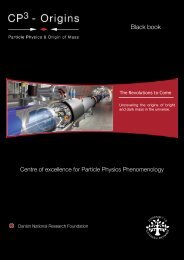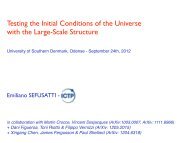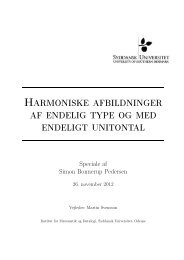Discovering Technicolor: Final Report for LHC School ... - CP3-Origins
Discovering Technicolor: Final Report for LHC School ... - CP3-Origins
Discovering Technicolor: Final Report for LHC School ... - CP3-Origins
Create successful ePaper yourself
Turn your PDF publications into a flip-book with our unique Google optimized e-Paper software.
2<br />
we know that the masses of the Z and W ± are not equal to zero than due to the Goldstones<br />
theorem we should have 3 broken generators among those generating the Electro Weak<br />
(EW) gauge trans<strong>for</strong>mations. Introducing a scalar Higgs boson can help us to give mass<br />
to the SM particles. Although no collider experimental result gives any deviation from<br />
SM prediction greater than 3σ (until lately, but there are 100s of measurements), there<br />
are still open problems:<br />
• Fine tuning: the first 32 digits of the tree level and one loop contributions to MH<br />
must cancel to give MH ≈ 100 GeV<br />
• Dark matter and energy: the SM describes only 4% of the Universes particle content<br />
• Neutrino masses: the SM assumes the neutrino massless; allowed Yukawa interactions<br />
would be un-naturally small<br />
• Matter-antimatter asymmetry: the relative abundance of matter cannot be generated<br />
by SM physics<br />
• Unication: a common origin of the observed <strong>for</strong>ces would reduce the theory arbitrariness;<br />
unication is ruled out in the SM<br />
II.<br />
DYNAMICAL SYMMETRY BREAKING AND TECHNICOLOR<br />
The main idea of technicolor is to replace the Higgs mechanism of EW symmetry<br />
breaking by introducing some new particles, techniquarks, which are gauged by an additional<br />
SU(N) T C group and are thus confined at some scale Λ T C which is chosen to be<br />
of the order of 3 TeV. In order to understand how that can be achieved, it is useful to<br />
start with considering a simple massless QCD with one quark generation q = (u, d) than<br />
possesses a classical chiral SU(2) L × SU(2) R symmetry which is known to be dynamically<br />
broken down to the isospin SU(2) V<br />
symmetry due to non-vanishing vacuum expectation<br />
value of quark-antiquark condensate < ¯qq > vac ≠ 0. The axial current j µa<br />
5 = ¯qγ µ γ 5<br />
τ a<br />
2 q<br />
of the broken symmetry is then effectively associated with its Goldstone bosons – pions:<br />
j µa<br />
5 = f π ∂ µ π a , where f π turns out to be the experimentally measured pion decay constant<br />
due to the matrix element < 0|j µa<br />
5 (x)|π b (q) >= −if π p µ e −ipx δ ab .








